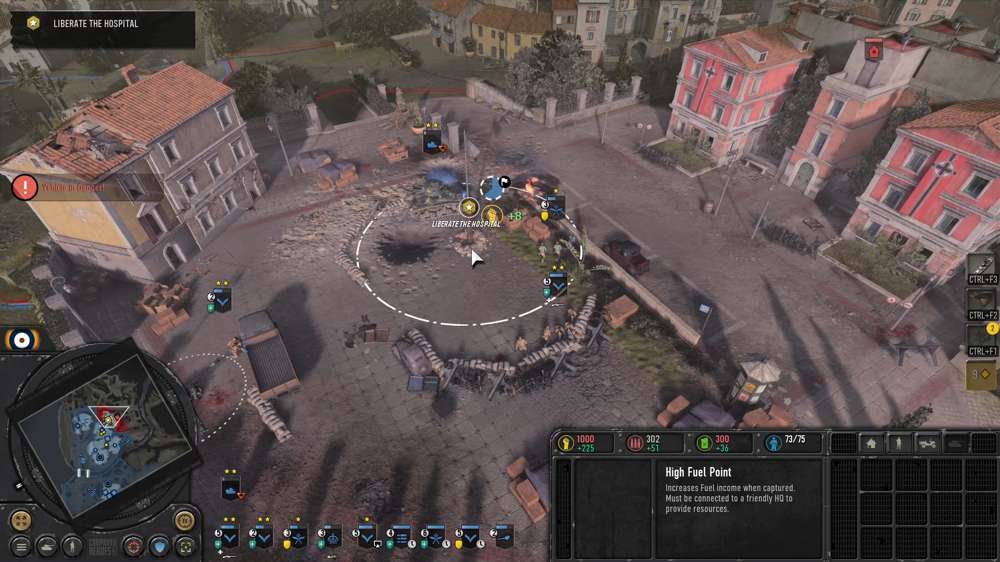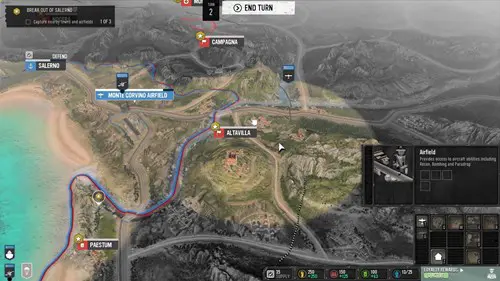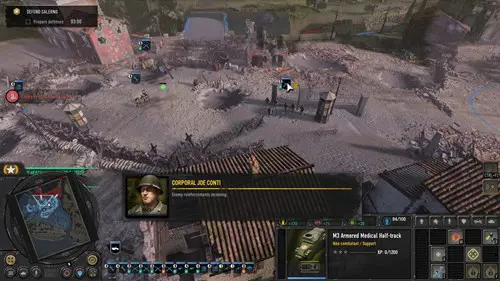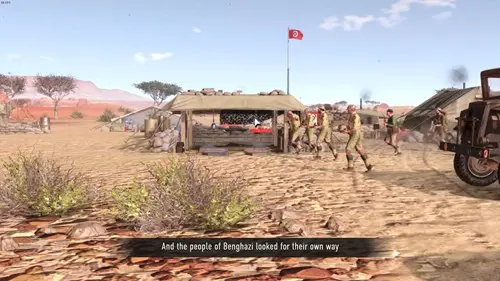Company of Heroes 3 review: "A great place to start for newcomers”
Check out our review of Company of Heroes 3, the latest entry in the WWII real-time strategy series by Relic Entertainment.

As someone who has previously struggled to get to grips with the real-time strategy genre, I was interested in Company of Heroes 3 for one simple reason: you can actually pause the action to think about your next steps.
I don't mean pause in the traditional press Esc and look at a bunch of options way. I mean pause in the sense of briefly taking the real-time out of the RTS. Tactical pause is a new feature to the franchise, letting you halt the action, analyse the battlefield, take stock of your options, and act by queuing up commands for all your units.
As simple a feature it may be, it really is a game changer for people like me who struggle with micromanagement, and it provided the foundation for me to start becoming that stereotypical RTS player 40 hours in, as I got used to flicking across the map to different engagements, making quick decisions on autopilot.
I'm by no means a real-time strategy expert now, but Company of Heroes 3 gave me the tools to get used to a genre that can be difficult to penetrate, and it let me do it on my own terms, making it one of the best introductory games out there.
Double feature

Company of Heroes 3 is in many ways the same as the previous two entries in the franchise, letting players tackle one of WWII's many theatres of war with a bird's eye view of real-time battles. But for the third entry, Relic wanted to go bigger. It didn't just settle for one location, instead offering a double feature of two campaigns: the 1943 Allied invasion of Italy, and the 1942 North African Operation.
The Italian campaign has received a lot of attention prior to release, as it followed on from the CoH 2 expansion Ardennes Assault by featuring a Total War-style turn-based tactical map. The gameplay becomes a lot more free-form and complex here, as you plot and execute your invasion of Italy one town at a time, dipping into real-time battles for specific missions and skirmishes with enemy units. This allows for a wide variety of battles to take place, consistently refreshing objectives between all-out assaults, defensive last stands, territorial domination, and much more.
There's a lot of room for strategy too, giving you a tonne of options in exactly how you approach the invasion, but it's based more around how you'll reach your end-goal (capturing Rome) than setting your own goals to follow. You can control individual units of land-based infantry or mechanised divisions for capturing towns and making headway into enemy territory, planes for bombing runs and reconnaissance, and ships which allow you to deploy troops further down the coast or provide bombing support for the land units to progress.
This structure also allows for a dynamic story to play out based on your decisions about what objectives to follow and which strategies to take. The British Forces, US Forces, and Italian Partisans are all represented by a key character who occasionally gives strategic advice, asks for favours that manifest as secondary objectives, or gives you story missions. There's even a loyalty system that forces you to balance your decisions, as alienating one character too much can cause them to not provide you with support for the final offensive on the Winter Line.
While the dynamic campaign map is a breath of fresh air and provides a level of meta-strategy that blends really well into the RTS gameplay, it can become a slog at some points when you're forced into one match, then another, and then another. The specific missions themselves are paced out well and provide a nice variety of objectives and terrain to complete them on, but the skirmish matches that occur when taking some towns or when engaged with enemy units can often feel like pointless endeavours. They're much quicker, but they get very stale when you play three in a row because an enemy choke point has three units that keep attacking you.
It's fair to say that overall, the inclusion of this campaign was a success, and it provides the kind of replay value that a more straightforward story-based campaign doesn't have. Speaking of which, wasn't there a second campaign to get to?
Playing with the enemy

The 1942 North African Operation is a more typical Company of Heroes campaign, following a linear, mission-driven structure that follows the exploits of the Deutsche Afrikakorps, headed up by the "Desert Fox" Erwin Rommel.
At first, it's definitely a bit jarring to play as the universally agreed bad guys in WWII, and it's the type of thing that can easily be handled very wrong, but Relic grounded the story in the perspective of the local African Jewish population, following the story of a man who joins up with the British to defend against the Nazi occupation and his family back in their village.
This story pans out during cutscenes, while the actual missions follow various real-life events from the perspective of the Afrikakorps. It's a much more personal framing of the war, tackling the effect on the civilian population that's often left to the wayside in favour of the glory and spectacle of battle.
A key moment where this is highlighted is during a scene where the daughter is writing a letter to her father, talking about the Allied bombing raids on her village, which did more damage to the native population than the German occupiers. Even the side that history accepts as the heroes weren't always so heroic, and it provides the kind of anti-war perspective that's often missing from games based on this period.
Now it doesn't exactly go all in on this viewpoint, and despite the earnest attempt at tackling the morally complex, brutal reality of war, right after these cutscenes you're put back into the fray and encouraged to slaughter the enemy and meet your objectives. However, I think it's important to note when media tries to responsibly portray warfare, as it's all too common for it to read like propaganda, something Company of Heroes 3 mostly manages to avoid.
The heat of battle

Obviously, the core of the Company of Heroes franchise is the RTS gameplay, and Relic have got pretty adept at making games in this genre by now, with CoH 3 proving they've still got it.
The mechanics are all pretty simple and based in some sense of logic that makes them easy to understand. The general gameplay consists of capturing various points around the battle map to increase your main resources: manpower, munitions, and fuel. Manpower and fuel are used to construct buildings and individual units, while munitions allow you to call in support like artillery, or use individual abilities with units like frag grenades or satchel charges. Finally, there is the population cap, which is the total amount of units you can field at once, with each unit costing a specific amount of population.
Company of Heroes 3 also offers the widest variety of units yet. This gives you room to construct the type of army you want, focusing more on infantry units, mechanised units, or a combination of the two. It's also worth mentioning the four different factions facilitate different styles of gameplay, with the US Forces excelling with flexible infantry, and the Afrikakorps boasting a fast and furious selection of mechanised units.
Whether you opt to use the tactical pause or not, after a while it's easy to start getting into a flow of decision-making as you learn the best methods to assault specific points, and when you should pull back to defend and recover. With the variety of objectives presented in missions across the campaigns, you'll also do plenty of learning on the job, and it's an incredibly satisfying feeling to find a winning strategy that compliments the army you've constructed.
It can be tempting to fall into zerg rush tactics, such as grouping all your units up and just going all in towards one place, but the game has plenty of ways to dissuade these kinds of choices, instead encouraging you to split units up and cleverly use the environment and the units' individual strengths to your advantage. For example, if you push all your infantry toward one point, an MG team can easily pin them all down, making it preferable to have a smaller garrison flank just as you go on the offensive, or have a tank provide cover and take out the MG first.
It's worth noting that the real-time battles have some weird difficulty spikes that ruin the consistency of whatever difficulty you have chosen sometimes, especially in regard to the North African campaign, where every mission just feels much harder than the Italian missions by default. The AI also feels like it has the wrong priorities, as I'd be in skirmishes or missions where they would focus on getting kills over playing objectives, which allowed me to just distract them and win easier than intended.
Despite some minor issues, Company of Heroes 3 nails the battles. There's a varied amount of ways to take part in them across the campaigns, the skirmish mode, and online multiplayer, and it brings the kind of incredible strategic depth that a veteran of this genre would appreciate unpacking.
The verdict

Company of Heroes 3 is an excellent game for veterans of the RTS genre and complete newbies who've never felt the rush of overseeing resources while micromanaging units on a virtual battlefield. Its double campaign feature provides two very distinct ways to experience the game, while the real-time strategy gameplay shows just how engaging and rewarding the genre can be if you give it the time and learn the systems in place.
4/5
Reviewed on PC. Code provided by the publisher.
Comments

